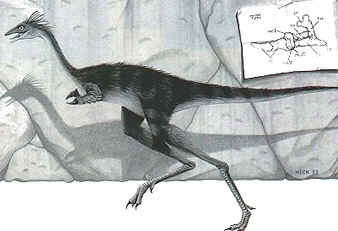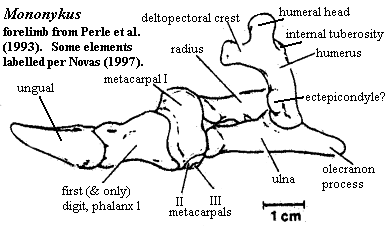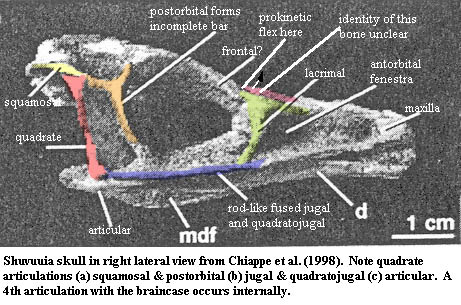 Mononykus: M. olecrans Perle et al. 1993.
Mononykus: M. olecrans Perle et al. 1993.| Coelurosauria | ||
| The Vertebrates | Mononykinae |
| Vertebrates Home | Vertebrate | Vertebrate |
|
Abbreviated Dendrogram
Dinosauria
├─Ornithischia
└─┬─Sauropodomorpha
└─Theropoda
│
└─Coelurosauria
├─Tyrannosauroidea
└─┬─Ornithomimosauria
└─┬─Maniraptora
├─Therizinosauroidea
└─┬─Alvarezsauridae
│ ├─Alvarezsaurus
│ └─Mononykinae
│ ├─Mononykus
│ └─┬─Parvicursor
│ └─Shuvuuia
├─Oviraptorosauria
└─Paraves
├─┬─Troodontidae
│ └─Dromaeosauridae
└─Aves
|
Contents
Index |
Mononykinae: Laurasian alvarezsaurs. Unnamed North American form [HC98]
Range: Late Cretaceous (Campanian - Maastrichtian) of North America & Mongolia [HC98]
Phylogeny: Alvarezsauridae:: Patagonykus + *: Mononykus + (Parvicursor + Shuvuuia).
Characters: hyposphene-hypantrum articulations absent; semilunate distal carpal covers all metacarpals (but how many are there?); ischial shaft lies along posterodorsal surface of pubic shaft, embraced in a groove towards proximal end [HC98]; pubic & ischial shafts of roughly equal length [HC98]; pubis body laterally compressed, laterally concave & medially convex [HC98]; pubis with prominent anteriorly directed preacetabular tubercle [HC98]; pubis opisthopubic forming angle of ~50° relative to iliac peduncle [HC98]; lesser & greater trochanters fused; popliteal fossa on distal femur closed distally by condyles; medial cnemial crest on proximal tibia; distal tibia with distinct condyles separated by tendinal groove on anterior surface; ascending process of astragalus slender, covering only lateral half of anterior tibia surface; Mt III does not reach proximal end of tarsus (fully arctometatarsalian).
Note: As noted by Hutchinson & Chiappe (1998), the apparent Late Cretaceous migration of alvarezsaurids from South America to Laurasia is consistent with some kind of temporary land bridge between North and South America during the Late Cretaceous. The same odd pattern of exotic Gondwanan species has been noted, for example, in connection with the appearance of titanosaurs in Laurasia.
Links: 415780a-s1.doc.
References: Hutchinson & Chiappe (1998) [HC98]. ATW020811.
 Mononykus: M. olecrans Perle et al. 1993.
Mononykus: M. olecrans Perle et al. 1993.
Range: Late Cretaceous (Campanian to Maastrichtian) of Mongolia (Nemegt & Djadokhta Formations)
Phylogeny: Mononykinae: (Parvicursor + Shuvuuia) + *.
Characters: ~90 cm; orbit connected with infratemporal fenestra [C95]; caudal & rostral tympanic recesses; accessory maxillary fenestra absent [P+93]; quadrate articulation anterior to otic recess [P+93]; maxilla edentulous [P+93]; small teeth on dentary and/or premaxilla [P+93]; teeth sharply pointed, laterally compressed, with distal & mesial carinae which broaden from tip to base [P+93]; long neck; vertebrae with very large neural canal [P+93]; caudal zygapophyses long, but not spanning adjacent centra [P+93]; cervical & dorsal vertebrae opisthocoelous [P+93] contra, [N97]); one posterior dorsal vertebra biconvex [P+93]; sacral vertebrae procoelous & transversely compressed [P+93]; posterior sacral vertebrae sharply keeled [P+93]; 19+ caudals [P+93]; proximal caudals with elongate hemal arches [P+93]; furcula unknown [P+93]; sternum longer than wide (as in birds) with thick carina [P+93]; coracoid not expanded ventrally [P+93]; humerus with large pectoral crest [P+93]; humerus with large proximal ventral tuberosity [P+93]; humerus with single distal condyle [P+93]; ulna & radius with very short shafts [P+93]; ulna with long, prominent olecranon process [P+93]; massive fused wrist (carpometacarpus) with at least 3 metacarpals and 1 distal carpal [P+93]; one robust manual digit digit I) [P+93]; digits II & III vestigial or absent [P+93]; robust ungual on digit I [P+93]; ilium with flat, horizontal posterior wing with shallow brevis fossa [P+93]; antitrochanter present [P+93]; ischium very slender [P+93]; opisthopubic [P+93]; pubic shaft proximally triangular in cross-section [HC98]; pubes & ischia do not meet in distal symphyses [P+93]; pubic "boot" absent [P+93]; long legs; femoral anterior & greater trochanters fused (as birds) [P+93]; depression near 4th trochanter for m caudofemoralis as in Patagonykus [N97]; popliteal fossa bounded distally by condyles [P+93]; "tibiotarsus" with medial cnemial crest [P+93]; tibia and proximal tarsals partially fused (tibiotarsus) in one specimen, but unfused in another [P+93]; tibiotarsus with fibula small and distally fused to tibia; metatarsals not fused [P+93]; metatarsal III limited to distal third and triangular in cross-section (extreme arctometatarsaly) [P+93]; Mts II & IV elongate, Mt I small & Mt V reduced to a splint [P+93]; phalangeal formula 23450 [P+93];
 Note: short arms and powerful muscles suggest fossorial lifestyle, but long legs inconsistent with this. Perhaps it was insectivore, attacking termite mounds. It would then, easily, have been the world's all time fastest and most nimble termite specialist.
Note: short arms and powerful muscles suggest fossorial lifestyle, but long legs inconsistent with this. Perhaps it was insectivore, attacking termite mounds. It would then, easily, have been the world's all time fastest and most nimble termite specialist.
Links: Mononykus; Nakasato Virtual Museum Mononykus (forelimb); DinoData Dinosaurs M134 MONONYKUS; National Geographic Magazine: July 1996 @ nationalgeographic.com; Mononykus -- The Dinosauricon; Paleontology and Geology Glossary: Mo; Mononykus Dutch); Mike Fredericks' Paleo Gallery @ Prehistorics Illustrated page 07; 'Nisarg' - A Birdlike Dinosaur?; Mononykus - Suite101.com.
Notes: [1] many of the features cited as diagnostic by Perle et al. later turned out to be common to all alvarezsaurids.
References: Chiappe 1995) [C95]; Hutchinson & Chiappe (1998) [HC98]; Novas (1997) [N97]; Perle et al. 1993) [P+93]. ATW020811.
Parvicursor: P. remotus Karhu & Rautian 1996.
Range: Late Cretaceous Campanian) of Mongolia
Phylogeny: Mononykinae:: Shuvuuia + *.
Characters: [1] small form ~1 m; vertebrae without pleurocoels [KR98]; all vertebrae with low neural spines [KR98]; all dorsal vertebrae opisthocoelous [KR98]; hyposphene-hypantrum articulations absent [KR98]; dorsal vertebrae with somewhat triangular articular surfaces (broader dorsally than ventrally) [KR98]; some dorsal vertebrae with ball in socket articulations; prezygapophyses short & do not reach level of anterior margin of centrum [KR98]; only 1st sacral vertebra is laterally compressed & carinate [C+98] [KR98]; 2nd & 3rd sacrals are broad & not carinate [KR98]; free caudals are procoelic and proximal caudals are laterally compressed [KR98]; caudal prezygapophyses long & extend beyond level of anterior margin of centrum [KR98]; anterior sacral vertebra with ventral keel [S+02]; $ pubic elements fused near acetabulum [KR98]; [2] dorsal part of acetabulum is medially concave [KR98]; $ acetabular foramen diameter <50% diameter of acetabular cavity [KR98]; ilium strongly expanded laterally dorsal to acetabulum [KR98]; pubic & ischial shafts closely appressed & directed posteroventrally [KR98]; no pubic symphysis [KR98]; $ proximal femur curved strongly in anterior direction [KR98]; femur with major & minor trochanters fused in single crest [KR98]; $ femur with 4th trochanter absent [KR98]; $ popliteal fossa open distally, separating distal femoral condyles [KR98]; $ tibiotarsus >1.5x length of femur [KR98]; single prominent cnemial crest [KR98]; only a spike of fibulae remains (rest fused with tibia), flattened proximally [KR98]; astragalus ascending process shifted laterally and proximal part fused with tibia [KR98]; extreme arctometatarsaly with Mt III only 25% length of others [KR98]; pes IV <50% length of metatarsal IV [S+02]; phalangeal formula 1?3450? [KR98]; unguals moderate size, roughly equal size and slightly curved [KR98].
Notes: [1] Karhu & Rautian (1998) proposed a new family, Parvicursoridae, to include only Parvicursor, to the exclusion of Mononykus. For various reasons, this has not been generally followed. The diagnostic characters of the proposed family have been treated here as characters of Parvicursor. [2] In other words, the acetabulum actually cuts into the top of the ilium. This feature, combined with the considerable curvature of the top of the leg, suggests that Parvicursor habitually stood (or squatted!) in a very odd position, with the proximal femur perhaps actually above the level of the pelvis. Consistent with this hypothesis of strange posture, the articulations between the femur and tibiotarsus (not described above) are also unusual, with the lateral articulations protruding much more strongly than, and apparently at a distinct angle from, the medial articulation [KR98].
Links: PARVICURSOR; DinoData Dinosaurs P047 PARVICURSOR remotus; Parvicursor -- The Dinosauricon.
References: Chiappe et al. 1998) [C+98]; Karhu & Rautian (1996) [KR96]; Suzuki et al. 2002) [S+02]. ATW031113.
 Shuvuuia: S. deserti Chiappe et al. 1998.
Shuvuuia: S. deserti Chiappe et al. 1998.
Range: Late Cretaceous Campanian) of Mongolia.
Phylogeny: Mononykinae:: Parvicursor + *.
Characters: nares terminal [C+98]; maxilla forms most of lateral rostrum [C+98]; prokinesis with mobility where rostrum reaches braincase [C+98]; prefrontal? (or ectethmoid?) very large [C+98]; lacrimal with long anterior process and small posterior process [C+98]; orbit large [C+98]; postorbital forms incomplete postorbital bar [C+98]; jugal does not contact postorbital [C+98]; jugal & quadratojugal fused to form jugal bar [C+98]; quadratojugal does not contact squamosal [C+98]; quadratojugal forms mobile joint with quadrate (clasps quadrate in small, unsutured Y-shaped terminus) [C+98]; quadrate has separate articulations with quadratojugal and squamosal [C+98]; quadrate tall & slender [C+98]; squamosal triradiate & not incorporated into braincase [C+98]; paroccipital processes short & not perforated by caudal tympanic recess [C+98]; foramen magnum large [C+98]; occipital condyle very small & posteriorly directed [C+98]; caudal tympanic recess & columellar recess confluent [C+98]; basipterygoid processes elongated & almost vertical [C+98]; palatine elongate & triradiate, lacking jugal process [C+98]; coronoid absent [C+98]; numerous teeth on premaxilla and on maxilla up to anterior 1/3 of antorbital fossa [C+98]; teeth in continuous groove in dentary [C+98]; cervical centra with large pneumatic foramina [C+98]; 1st sacral not carinate [C+98]; humerus deltopectoral crest confluent with humeral head [C+98]; pubis circular in cross-section [C+98]; pubic shaft laterally compressed [HC98]; femur and tibiotarsus bowed [C+98]; $ distal tibiotarsus with sharp ridge on the medial margin [C+98]; proximal tarsals and metatarsals less fused than in Mononykus & Parvicursor [C+98]; ß-keratin (feather protein) present by immunology, ultrastructure and (less convincingly) mass spectroscopy [S+99].
 Links: DinoData Dinosaurs S070 SHUVUUIA deserti; Shuvuuia Fact Sheet - EnchantedLearning.com; Shuvuuia deserti; OLogy; Shuvuuia -- The Dinosauricon; SHUVUUIA DESERTI Dutch); ScienceDaily Magazine -- Researchers Announce Discovery Of Skulls Of Bizarre Animals Showing Advanced Stage In Transition Between Dinosaurs And Birds; Bird Dinosaur Link; Fighting Dinosaurs | American Museum of Natural History; \Feathered\ Dinosaurs.
Links: DinoData Dinosaurs S070 SHUVUUIA deserti; Shuvuuia Fact Sheet - EnchantedLearning.com; Shuvuuia deserti; OLogy; Shuvuuia -- The Dinosauricon; SHUVUUIA DESERTI Dutch); ScienceDaily Magazine -- Researchers Announce Discovery Of Skulls Of Bizarre Animals Showing Advanced Stage In Transition Between Dinosaurs And Birds; Bird Dinosaur Link; Fighting Dinosaurs | American Museum of Natural History; \Feathered\ Dinosaurs.
References: Chiappe et al. 1998) [C+98]; Hutchinson & Chiappe (1998) [HC98]; Schweitzer et al. (1999) [S+99]. ATW020811.
checked ATW050717